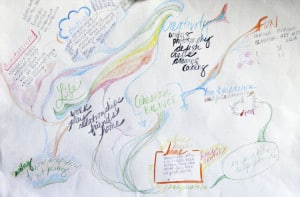How will a mindmap benefit your writing life? As someone who has spent the last ten years working with writers to help them lay out their ideas and organize them into a cohesive writing roadmap, I vouch for the benefits of mindmapping as a tool that helps you stop worrying about perfection so you can generate ideas.
It’s a creative method that allows you to effectively group different kinds of information and see patterns in your thinking and highlight potential blocks or solutions.
Read on to learn more about this creative technique as well what you need to create a mind map of your own and how to make it work for you.
What is a mindmap?
A mind map is a visual diagram of ideas grouped together around a central idea. You begin with a single word or idea and then brainstorm from there. Instead of making a long list or randomly placing words around the page, mindmaps ask you to group ideas and make connections as you get them on paper.
Since mindmaps are visual, the best way to understand them is to see one.

How to make your own mindmap
Tools & Supplies You’ll Need
???? Something to write on
I use printer paper. You use what you want. Canvas, material, construction paper or something else entirely. You can do this on your computer if you really want to, but then you lose out on the benefits of writing by hand.
???? Something with which to write, draw or paint
You can keep it simple and use a regular pen or graphite pencil. I like colored pencils. They allow me to write clearly with a clean, fine point, but I can change colors to differentiate between ideas and topics. Also consider oil pastels, paint, markers, magazine cuttings, rubber stamps or anything that feels good in your hand or you enjoy putting on paper.
Getting Started With Your Mind Map
Lay your paper horizontally. This will give you a wide canvas on which to lay out your ideas.
Begin by writing down the top three or four most important parts of your life such as home life, work, family, creativity, writing. Leave enough space around each item for you to list the branches and connections with that item.
Once you have your top ideas on paper, choose one topic and list all the areas you connect with that topic.
Your home life, for example, may include renovations, shopping, cooking, setting up an area for you to write, finding time to sleep more, hanging out with your kids.
Or your work life can include your different work projects, meetings, conferences, when you take breaks, what you eat for lunch and anything else that pertains to your work life.
You lay out all your options, ideas, concerns and desires visually on paper. You use color; you draw. You let go of crafting or editing and just get it all down on paper.
Are you writing a novel, designing a new business, scheduling out your blog posts for the year? Write down the people, the events, places, times, problems, themes, goals or anything else you deem as significant.
Use lines to draw connections between the pieces that go together. Group concepts together as you find appropriate.
Tony Buzan, who popularized the term mind map gives these guidelines:
- Start in the center with an image of the topic, using at least 3 colors.
- Use images, symbols, codes, and dimensions throughout your mind map.
- Select key words and print using upper or lower case letters.
- Each word/image is best alone and sitting on its own line.
- The lines should be connected, starting from the central image. The central lines are thicker, organic and thinner as they radiate out from the centre.
- Make the lines the same length as the word/image they support.
- Use multiple colors throughout the mind map, for visual stimulation and also to encode or group.
- Develop your own personal style of mind mapping.
- Use emphasis and show associations in your mind map.
- Keep the mind map clear by using radial hierarchy, numerical order or outlines to embrace your branches.
Ultimately, you’ll focus on what you believe to be important, significant and necessary for your life. Even if some ways you think a concept is too small to be in the big picture, but it keeps appearing, put it down on paper.
There is no right or wrong. There is only getting whatever it is in your head onto paper.
Making connections between the areas of your life
Read through your mind map and see where ideas repeat.
Does “taking breaks” or “self-care” or other similar things span more than one area of your life?
Do the projects from one area connect to other areas?
Can the work you do in one space support what you do in another?
What areas are your favorites?
Which ones do wish you could cut out?
What patterns do you notice on the page?
This is what happened with my mindmap
Years ago, before I wrote my book The Writer’s Roadmap: Paving the Way To Your Ideal Writing Life, my life had been feeling out of balance. I spent too much time online. I was overwhelmed by the number of projects I had happened. Between maintaining this blog, organizing my non-profit activities at Cloudhead, parenting, being married and, oh, eating and sleeping, I never had time to really focus on any one thing.
My writing suffered because how can you write or be creative when you cannot stop long enough to really focus?
Simply put, you can’t.
The problem with not being able to focus, though, is it’s impossible to see the big picture clearly enough to make changes. I decided to make a mindmap to give myself a visual overview of my life.
I started with the word LIFE and let it branch from there.
I included my writing business, the non-profit I founded and ran in Argentina, my home life, self-care, writing and also included the values I wanted to infuse into my life. Those values were creativity, cohesion and balance.
This is what I made:

What I noticed when making connections
Balance and cohesion live at the center of my mind map. They connect all the other pieces. Yoga, meditation, my home, creativity and having fun allow me to relax and enjoy my work. All of these things take up a lot of space on my map.
My work life occupies a much smaller area of the page — about 20%. I realized I had to shift my time away from being online and toward creating cohesion and balance. That meant I needed to prioritize taking care of myself, from eating well to yoga to getting enough sleep.
I needed clear boundaries between my work time and the rest of my life, because without them, I’d never find the balance I needed.
How I turned my mind map to action
✅ I set specific work hours. I don’t look at my computer or phone until those hours begin, and I shut them down when those hours end.
✅ I tracked and measured my computer time. This allowed me to see where I was best using my time, and I cut out everything else.
✅ I developed a writing practice and set aside every morning for creative work.
✅ I prioritized self-care. That means getting enough sleep, eating well, and meditating regularly. I don’t allow myself to work or do anything else until I’ve made sure to take care of myself
✅ I set boundaries in all areas of my life. One of the hardest parts of setting boundaries is saying no and claiming your time for yourself.
Our minds are always working. Mindmaps tap into the unconscious needs we have. We form patterns of ideas, group colors and create affinities and aversions to certain words. These will show up in your mind maps. When you pay attention to the connections you uncover, you’ll naturally create systems for yourself which in turn allows you to see your life more consciously and create order out of your creative chaos.

